Wattlebird
| Wattlebirds | |
|---|---|
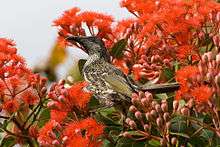 | |
| Anthochaera chrysoptera | |
| Scientific classification | |
| Kingdom: | Animalia |
| Phylum: | Chordata |
| Class: | Aves |
| Order: | Passeriformes |
| Family: | Meliphagidae |
| Genus: | Anthochaera |
| Species | |
|
see text | |
Wattlebirds (Anthochaera) is a genus of birds in the honeyeater family. The species are native to Australia and include the little wattlebird, the red wattlebird, the western wattlebird, and the yellow wattlebird. Recent evidence suggests the regent honeyeater belongs in this genus.
Of the five species in the genus only the yellow wattlebird and the red wattlebird have wattles.[1] These are bare fleshy appendages, usually wrinkled and often brightly coloured, hanging from the cheeks, neck or throat, and presumably serving for display.
Some other birds also have wattles, although they are not known by the term "wattlebird". Examples include the turkey; some vultures; and several species of lapwing. The entire Callaeidae family of New Zealand, comprising the tieke (also known as the saddleback), the kokako, and the extinct huia, are also known as wattlebirds, but are unrelated to this genus.
The regent honeyeater (Anthochaera phrygia) was formerly placed in its own genus Xanthomyza but was moved to Anthochaera based on phylogenetic analysis using DNA sequence data.[2][3]
The genus Anthochaera was introduced in 1827 by the naturalists Nicholas Aylward Vigors and Thomas Horsfield.[4][5] The word Anthochaera is derived from the Greek anthos meaning flower or bloom and khairō meaning to enjoy.[6]
The genus Anthochaera contains the following species:[3]
| Image | Scientific name | Common Name | Distribution |
|---|---|---|---|
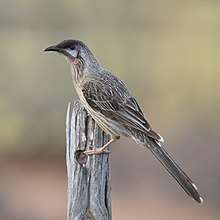 | Red wattlebird | Anthochaera carunculata | southeast Queensland, New South Wales, Victoria, South Australia and southwest Western Australia |
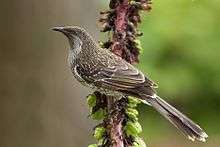 | Little wattlebird | Anthochaera chrysoptera | coastal and sub-coastal south-eastern Australia |
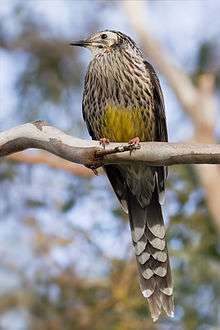 | Yellow wattlebird | Anthochaera paradoxa | Tasmania |
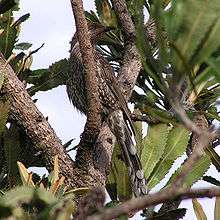 | Western wattlebird | Anthochaera lunulata | south-western Australia. |
.jpg) | Regent honeyeater | Anthochaera phrygia | South Eastern Australia |
A molecular phylogenetic analysis has shown that the genus Anthochaera is the sister group to the monotypic genus Acanthagenys containing the Spiny-cheeked honeyeater.[7]
|
| ||||||||||||||||||||||||||||||||||||
| Cladogram showing the relationship between the wattlebirds.[7] |
See also
References
- ↑ Higgins, P.; Christidis, L.; Ford, H.; Bonan, A. (2008). "Honeyeaters (Meliphagidae)". In del Hoyo, J.; Elliott, A.; Sargatal, J.; Christie, D.A.; de Juana, E. Handbook of the Birds of the World Alive. Lynx Edicions. Retrieved 23 January 2017. (Subscription required (help)).
- ↑ Driskell, A.C.; Christidis, L. (2004). "Phylogeny and evolution of the Australo-Papuan honeyeaters (Passeriformes, Meliphagidae)". Molecular Phylogenetics and Evolution. 31 (3): 943–960. doi:10.1016/j.ympev.2003.10.017.
- 1 2 Gill, Frank; Donsker, David (eds.). "Honeyeaters". World Bird List Version 5.4. International Ornithologists' Union. Retrieved 26 December 2015.
- ↑ Vigors & Horsfield 1827, pp. 320-321.
- ↑ Salomonsen 1967, pp. 444-445.
- ↑ Jobling 2010, p. 49.
- 1 2 Marki, P.Z.; Jønsson, K.A.; Irestedt, M.; Nguyen, J.M.; Rahbek, C.; Fjeldså, C. (2017). "Supermatrix phylogeny and biogeography of the Australasian Meliphagides radiation (Aves: Passeriformes)". Molecular Phylogenetics and Evolution. 107: 516–529. doi:10.1016/j.ympev.2016.12.021.
Sources
- Jobling, J.A. (2010). The Helm Dictionary of Scientific Bird Names. London: Christopher Helm. ISBN 978-1-4081-2501-4.
- Salomonsen, F. (1967). "Family Maliphagidae, Honeyeaters". In Paynter, R.A. Jnr. Check-list of birds of the world (Volume 12). Cambridge, Mass.: Museum of Comparative Zoology. pp. 338–450.
- Vigors, N.A.; Horsfield, T. (1827). "A description of the Australian birds in the collection of the Linnean Society; with an attempt at arranging them according to their natural affinities (Part 1)". Transactions of the Linnean Society of London. 15 (1): 170–331. doi:10.1111/j.1095-8339.1826.tb00115.x. The title page of the issue has the year 1826.
External links
- Wattlebird videos on the Internet Bird Collection
- TerraNature pages on New Zealand wattlebirds